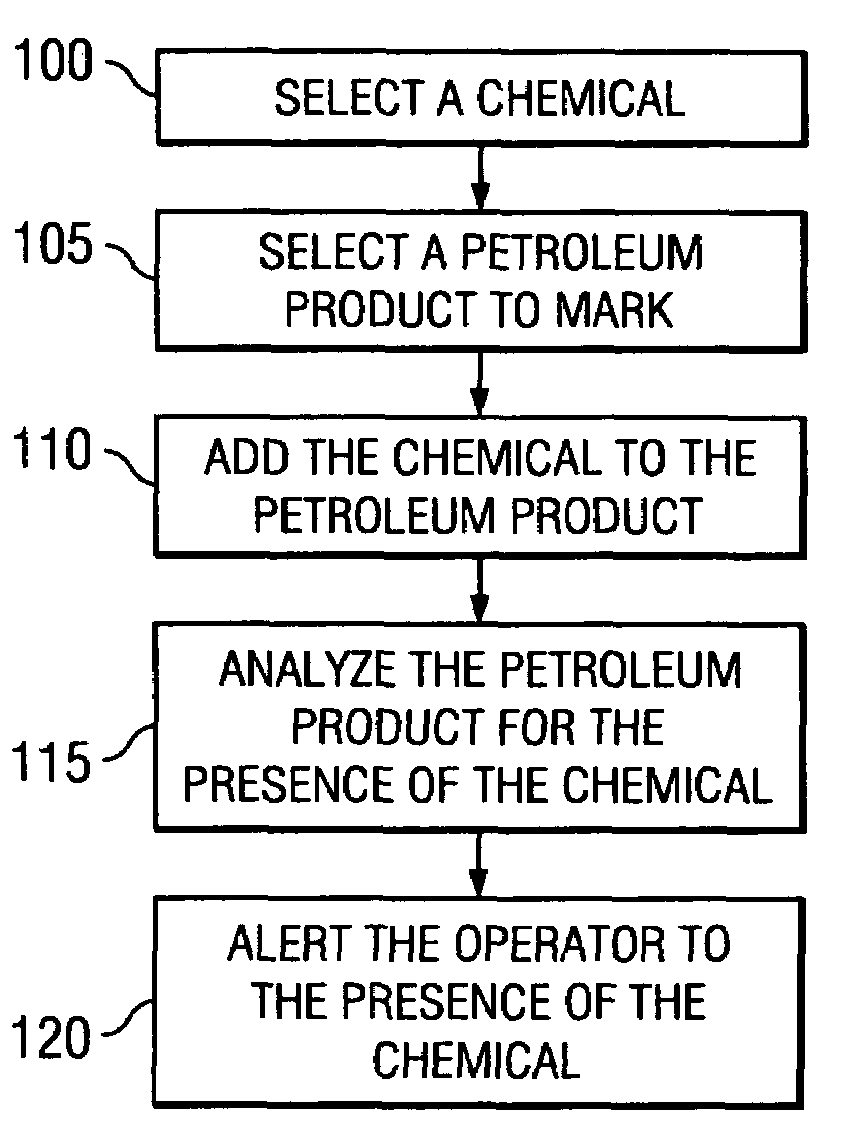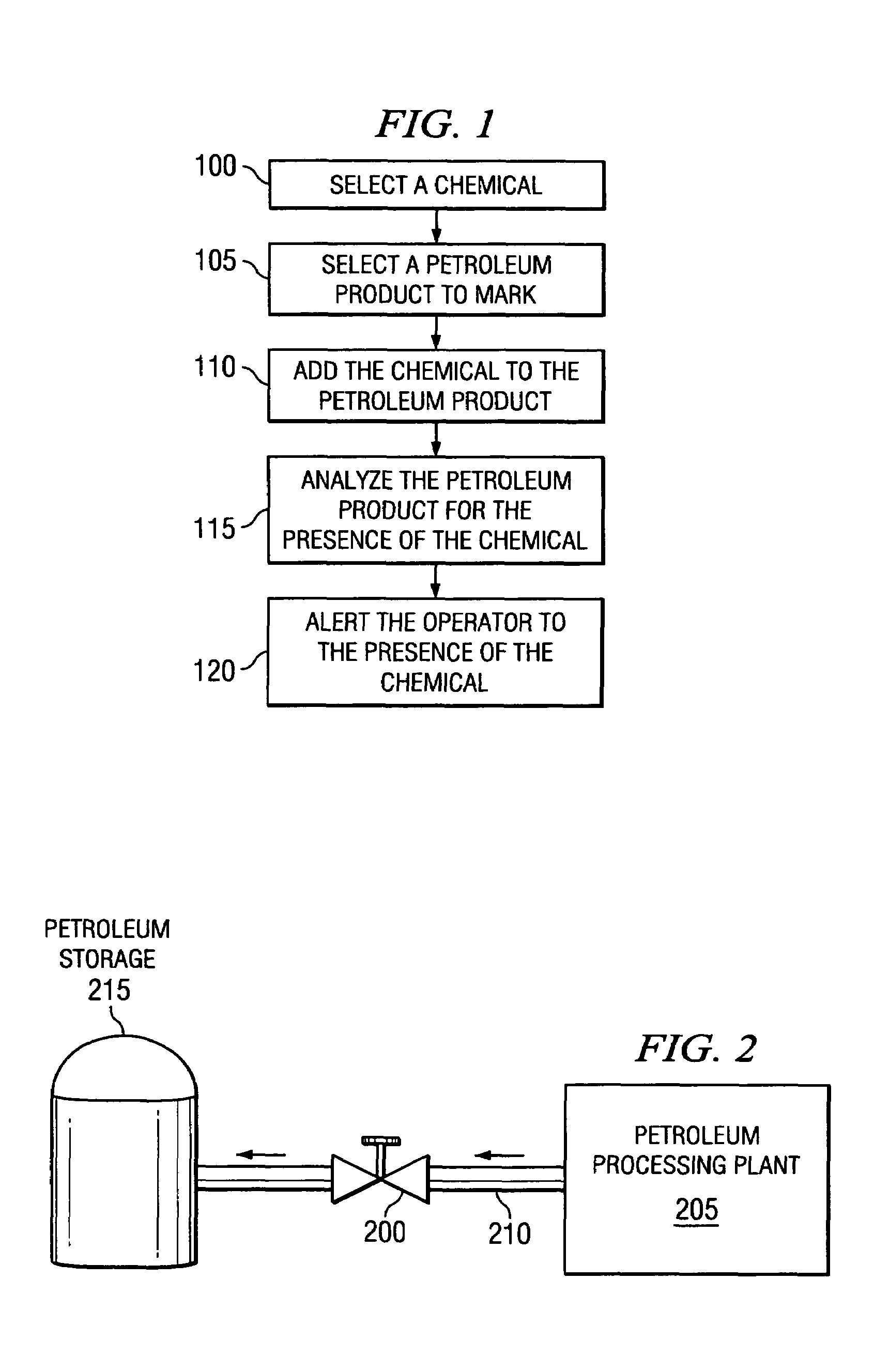IMS detection of chemical markers in petroleum products
a technology of chemical markers and petroleum products, applied in the field of ims detection of chemical markers in petroleum products, can solve the problems of tax evasion by passing custody markers, chemical should not be easily removed using simple methods, etc., and achieve the effects of improving ion generation, detection, and data interpretation
- Summary
- Abstract
- Description
- Claims
- Application Information
AI Technical Summary
Benefits of technology
Problems solved by technology
Method used
Image
Examples
example one
[0030]4-heptanone is selected as the tagging chemical for use with diesel fuel in an 8,500-gallon tanker truck. 4-heptanone is an alkyl ketone with the double bonded oxygen on the 4th carbon. The ketone, or A group, is in the middle of the compound thus making the dipole of the compound lower and therefore not as likely to be extracted by polar solvents. The boiling point for 4-heptanone is 145° C. and is within the desired range of 100°–250° C. for ketones. Approximately 10 gallons of diesel fuel is withdrawn from the tanker truck and mixed with 8.19 gallons of undiluted 4-heptanone. The resulting mixture is delivered back into the tanker truck to produce an overall concentration of 1 ppm 4-heptanone in the diesel fuel, assuming the density of the diesel fuel is 7.079 lb / gal, and the density of 4-heptanone is 6.8225 lb / gal. The concentration of 4-heptanone is within the desired concentration range of 1 ppb–100 ppm. The natural transporting of the diesel fuel thoroughly mixes the 4-...
example two
[0031]6-undecanone was selected as the tagging chemical for use with diesel fuel in a 150,000-gallon above ground storage tank. 6-undecanone is an alkyl ketone with the double bonded oxygen on the 6th carbon. The ketone, or A group, is in the middle of the compound thus making the dipole of the compound lower and therefore not as likely to be extracted by polar solvents. The boiling point for 6-undecanone is 191° C. and is within the desired range of 100°–250° C. for ketones. Approximately 10 gallons of diesel fuel was withdrawn from the storage tank and mixed with 147 gallons of undiluted 6-undecanone. The resulting mixture is delivered back into the storage tank to produce an overall concentration of 1 ppm 6-undecanone in the diesel fuel which is within the desired concentration range of 1 ppb–100 ppm, assuming the density of the diesel fuel is 7.079 lb / gal and the density of 6-undecanone is 6.9394. The 6-undecanone and diesel fuel thoroughly mixed using Vaughan's Rotamix system. ...
example 3
[0032]Methylphenylethyl amine is selected as the tagging chemical for use with jet fuel in an 8,500-gallon tanker truck. Methylphenylethyl amine has a relatively low dipole and is not as likely to be extracted by polar solvents. The boiling point for methylphenylethyl amine is 197–207° C. and is around the desired range of 200°–2500 C. Approximately 9.469 gallons of methylphenylethyl amine is added directly into the tanker truck to produce an overall concentration of 1 ppm Methylphenethyl amine which is within the desired concentration range of 1 ppb–100 ppm. The natural transporting of the jet fuel thoroughly mixed the methylphenethyl amine with the jet fuel. Upon arrival at the final destination of the jet fuel, a handheld IMS designed specifically for the detection of amines will able to detect the presence of methylphenylethyl amine in the jet fuel.
PUM
| Property | Measurement | Unit |
|---|---|---|
| boiling point | aaaaa | aaaaa |
| boiling points | aaaaa | aaaaa |
| boiling points | aaaaa | aaaaa |
Abstract
Description
Claims
Application Information
 Login to View More
Login to View More - R&D
- Intellectual Property
- Life Sciences
- Materials
- Tech Scout
- Unparalleled Data Quality
- Higher Quality Content
- 60% Fewer Hallucinations
Browse by: Latest US Patents, China's latest patents, Technical Efficacy Thesaurus, Application Domain, Technology Topic, Popular Technical Reports.
© 2025 PatSnap. All rights reserved.Legal|Privacy policy|Modern Slavery Act Transparency Statement|Sitemap|About US| Contact US: help@patsnap.com


